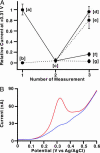Single-nucleotide polymorphism detection with "wire-like" DNA probes that display quasi "on-off" digital action
- PMID: 16087881
- PMCID: PMC1183446
- DOI: 10.1073/pnas.0502078102
Single-nucleotide polymorphism detection with "wire-like" DNA probes that display quasi "on-off" digital action
Abstract
Establishing a reliable genotyping protocol is a critical matter in post-sequence genetics. In this article, we describe a highly sensitive electrochemical detection of complementary DNAs (up to 43-mer) based on hole transport with molecular-scale, "wire-like" DNA probes. The presence of a single-base mismatch in the DNA duplexes caused a dramatic decrease in the electrochemical response. We applied this method to detect all of the possible transition and transversion SNPs and achieved "on-off"-type discrimination of fully complementary DNAs from their SNPs. Furthermore, naturally occurring polymorphisms, "hot spots" from the p53 gene, could clearly be distinguished from wild type by using our methodology.
Figures



References
-
- Brookes, A. J. (1999) Gene 234, 177–186. - PubMed
-
- McCarthy, J. J. & Hilfiker, R. (2000) Nat. Biotechnol. 18, 505–508. - PubMed
-
- van Staveren, D. R. & Metzler-Nolte, N. (2004) Chem. Rev. 104, 5931–5985. - PubMed
-
- Drummond, T. G., Hill, M. G. & Barton, J. K. (2003) Nat. Biotechnol. 21, 1192–1199. - PubMed
Publication types
MeSH terms
Substances
LinkOut - more resources
Full Text Sources
Other Literature Sources
Research Materials
Miscellaneous

